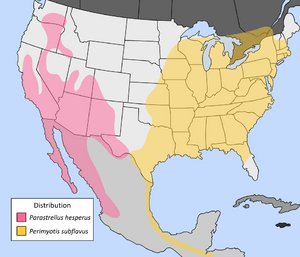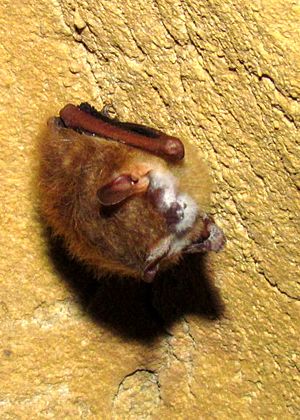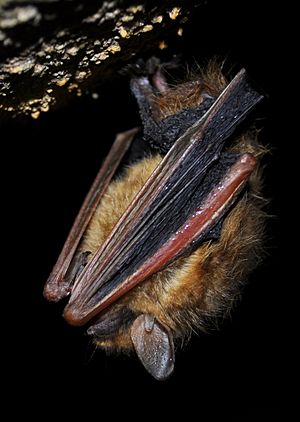Tricolored bat facts for kids
Quick facts for kids Tricolored bat |
|
|---|---|
 |
|
| Conservation status | |
| Scientific classification | |
| Genus: |
Perimyotis
|
| Species: |
subflavus
|
 |
|
| Range of tricolored bat (in yellow) | |
| Synonyms | |
|
|
The tricolored bat (Perimyotis subflavus) is a small bat that lives in eastern North America. It used to be called the "eastern pipistrelle." This was because people thought it was related to bats in Europe. However, scientists now know its closest relative is the canyon bat.
This bat gets its name "tricolored" from the special hairs on its back. Each hair has three different color bands! It is the smallest bat in the eastern and midwestern United States. These tiny bats weigh only about 4.6 to 7.9 grams (less than a quarter).
Tricolored bats mate in the fall before they hibernate for winter. But the females don't get pregnant until spring. Baby bats are born helpless, but they grow up very fast. They can fly and find their own food by the time they are four weeks old. These bats can live for a long time, sometimes almost fifteen years.
In the summer, female bats rest in small groups. Male bats usually rest alone in tree leaves or special beard lichen. Tricolored bats eat many different kinds of insects. They fly slowly and unevenly to catch their food. They use echolocation (like sonar) to find their way around and hunt.
This bat used to be very common. But since 2006, its numbers have dropped a lot. This is because of a fungal disease called white-nose syndrome. In Canada, it was listed as an endangered species in 2012. People in the U.S. are also trying to get it listed as endangered.
Contents
About the Tricolored Bat's Name
A French scientist named Frédéric Cuvier first described the tricolored bat in 1832. He gave it the scientific name Vespertilio subflavus. Later, in 1897, an American scientist named Gerrit Smith Miller thought it looked like bats in the Pipistrellus group. So, he changed its name to Pipistrellus subflavus. This is why it was called the "eastern pipistrelle" for a long time.
In 1984, another scientist, H. Menu, looked closely at the bat again. He decided it was more like bats in the Myotis group. So, he created a new group (genus) for it called Perimyotis. The name "Perimyotis" means "around Myotis." This shows its similarities to the Myotis bats.
At first, not everyone agreed with this new name. But in 2003, a study using genetics (DNA) showed that the tricolored bat was indeed different from Pipistrellus bats. This study confirmed that Perimyotis was a good name for its own group. Today, most scientists agree that its scientific name is Perimyotis subflavus. Its common name was changed to "tricolored bat" to match this new scientific understanding.
The word "subflavus" in its scientific name means "a little less than yellow." This describes its yellowish or pale yellow color.
There are four recognized types (subspecies) of tricolored bats:
- P. s. clarus
- P. s. floridanus
- P. s. subflavus
- P. s. veraecrucis
What the Tricolored Bat Looks Like
The tricolored bat has light brown fur. The fur on its back is clearly tricolored. Each hair is dark gray at the bottom, yellowish-brown in the middle, and brown or reddish-brown at the tip.
It is the smallest bat species in the eastern and midwestern parts of the United States. Its forearm (part of its wing) is about 31.4 to 34.1 millimeters long. It weighs about 4.6 to 7.9 grams. Its forearms are reddish, which stands out against the black parts of its wings. Its wingspan (how wide its wings are when spread out) is about 21 to 26 centimeters. This bat has 34 teeth.
Biology and Ecology
Reproduction and Life Cycle
Tricolored bats mate in the fall, before they go into hibernation for the winter. However, the female bats do not release their eggs until spring. They store the male's sperm in their bodies through the winter.
Pregnancy lasts about 44 days. Females usually give birth in June or July. They typically have two babies at a time. When they are born, the baby bats (called pups) have no fur and their eyes are closed. The mother leaves her pups at the roost (resting place) while she goes out to find food at night.
The young bats grow very quickly. They start flying when they are about three weeks old. By four weeks old, they can find food for themselves. Young bats do not mate in their first fall. They wait until their second fall to breed.
Tricolored bats can live for at least 14.8 years in the wild. Young bats are more likely to die than adult bats. Female bats also have a higher death rate than males.
Behavior
In the summer, tricolored bats rest in tree leaves or sometimes in buildings. Female bats might be alone or in groups of up to thirty bats, called maternity colonies. They use trees like oak, maple, eastern cottonwood, and American tulip tree. Male bats usually rest alone and do not form colonies.
In Nova Scotia, Canada, scientists found that these bats were resting in a type of beard lichen called Usnea trichodea. This was the first time a bat was seen using beard lichen as a resting spot. Scientists think the bats might use the lichen to keep away parasites. Beard lichens contain a substance called Usnic acid, which can fight insects and bacteria. No external parasites have been found on tricolored bats in Nova Scotia.
In winter, tricolored bats hibernate in mines, caves, or other human-made structures. A study in Nebraska found that a mine was mostly used by male bats in the summer. During winter, more bats used the mine for hibernation. Bats were in a deep sleep (called torpor) from November to April. During hibernation, males lose about 2.65 grams, and females lose about 2.5 grams.
Diet and Foraging
The tricolored bat eats only insects (it is insectivorous). It prefers small prey that are about 4 to 10 millimeters long. Its diet includes mosquitoes, beetles, ants, moths, and cicadas.
It hunts for food with a slow, uneven flight. It often forages near water or at the edges of forests. It is one of the first bat species to start hunting each night. It uses echolocation (sonar) to find its way and locate prey. Its echolocation calls are very high-pitched. When seen on a special graph, the calls look like a hook shape. The lowest sound frequencies are at 42 kilohertz.
Predators, Parasites, and Disease

Natural predators of the tricolored bat include the northern leopard frog, birds that hunt, raccoons, snakes, skunks, and prairie voles. Wild cats can also catch and kill them when they leave their hibernation spots. There are also reports of the hoary bat attacking them.
Tricolored bats can host several types of parasites, both inside and outside their bodies.
The tricolored bat population has greatly decreased because of a fungal disease called white-nose syndrome. This disease arrived in the U.S. in 2006. In many U.S. states, more than 70% of the bats have been lost. The disease harms bats by growing on their skin during winter. This makes them wake up from their deep sleep too often. When they wake up, they use up their stored fat reserves, which can cause them to starve.
Even though their numbers dropped sharply, some studies show that their populations might be becoming more stable. However, places where many bats used to hibernate now only have a few, or sometimes just one bat.
Where the Tricolored Bat Lives
The tricolored bat is found across eastern North America. Its range goes from Central America in the south to southern Canada in the north. Since the 1980s, its range has grown westward. It now reaches the U.S. states of Colorado, New Mexico, South Dakota, and Wyoming. It has also started to live in the Great Lakes Basin.
Conservation Efforts
As of 2018, the IUCN lists the tricolored bat as a vulnerable species. This means it is at risk of becoming endangered. However, in 2008, it was considered a least-concern species, which is the lowest conservation priority.
The change happened because the fungal disease white-nose syndrome spread widely in eastern North America. This disease severely affected the tricolored bat. Historically, it was one of the most common bat species in eastern North America.
After an urgent review, the tricolored bat was listed as an endangered species in Canada in 2012. In 2016, two groups, the Center for Biological Diversity and Defenders of Wildlife, asked the United States Fish and Wildlife Service (USFWS) to list the tricolored bat under the Endangered Species Act of 1973. The USFWS decided that there was enough reason to consider listing the species as "threatened" or "endangered." As of 2019, this decision was still being reviewed.
Tricolored Bats and People
The tricolored bat is one of two bat species linked to most human rabies cases from bats in the U.S. It's important to know that human rabies cases from bats are very rare. Also, many of these cases are "cryptic rabies," meaning people don't remember being bitten.
From 1958 to 2000, a small number of people in the U.S. died from the type of rabies linked to tricolored bats. This was about 46% of all rabies deaths in the country that were not from animals caught elsewhere.
People don't often come across tricolored bats. In 2017, only 31 tricolored bats were tested for rabies in the U.S. Only one of them (about 3.4%) tested positive for the virus. It's always safest to never touch a bat you find, and to tell an adult if you see one that seems sick or is on the ground.
See also
 In Spanish: Pipistrellus subflavus para niños
In Spanish: Pipistrellus subflavus para niños



